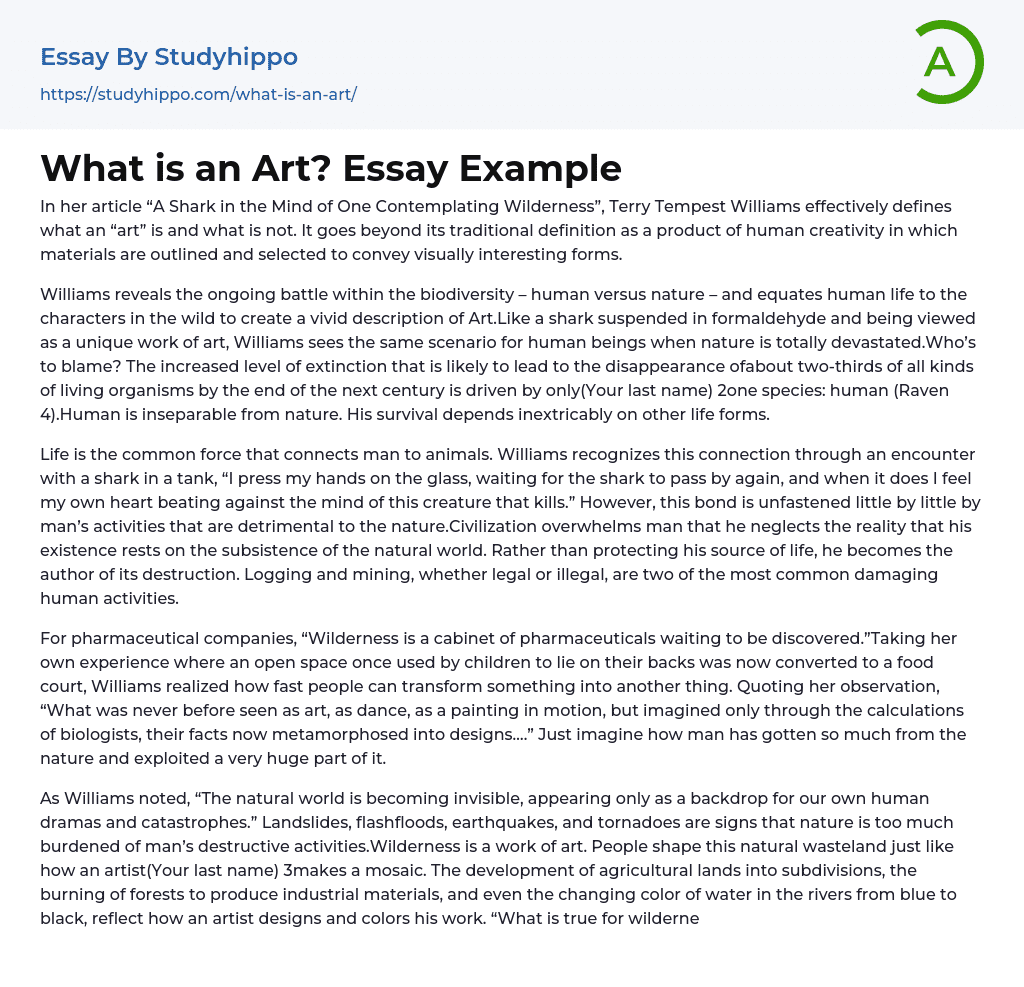Terry Tempest Williams offers a comprehensive interpretation of the term "art" in her work, "A Shark in the Mind of One Contemplating Wilderness," which goes beyond the typical definition of a visually appealing item made by human ingenuity that involves choosing and shaping materials.In discussing the state of biodiversity, Williams highlights the ongoing conflict between humans and nature, painting a vivid picture of the relationship between human life and the wild. The author draws a parallel between humans and a preserved shark displayed as a unique work of art, suggesting that if nature continues to be destroyed, humans will meet a similar fate. The cause of this destruction is clear: according to Raven (4), it is human activity that has caused an increase in extinction rates, putting two-thirds of all living organisms at risk of disappearing by the end of the next c
...entury. Williams emphasizes that humans are intertwined with nature, relying on other forms of life for survival.
Williams recognizes the shared connection between humans and animals, powered by life itself. During a close encounter with a shark in a tank, he feels his heart beating in unison with that of the creature. Nevertheless, human actions that harm nature are gradually severing this bond. Civilization has consumed humanity to such an extent that it forgets its survival hinges on the preservation of the natural world. Rather than safeguarding this essential source of existence, people are responsible for destroying it through activities like logging and mining - whether sanctioned or unlawful.
Pharmaceutical companies claim that the wilderness is a rich source of undiscovered medicines, an idea initially brought to light by Williams. She observed how space
were rapidly transformed, like a children's play area becoming a food court. Williams noted that what was once only considered from a biological perspective has now become inspiration for other fields like art, dance, and motion painting. Essentially humans have utilized nature to extract vast resources from it.
According to Williams' observation, nature is gradually becoming invisible and merely serves as a background for human dramas and catastrophes. The occurrence of landslides, flash floods, earthquakes, and tornadoes are indications that human activities have put a strain on the natural environment. Wilderness is a form of artistic beauty that people can shape, like an artist creating a mosaic. The transition of agricultural land into subdivisions, deforestation for industrial production, and even the change of river water from blue to black is comparable to an artist's design and color choices. The same holds true for humans as it does for wilderness.
According to Amato-Grill (5), human society is a mixture of various elements such as fields, forests, city blocks, and subway tiles. To truly comprehend human nature, we must look to this amalgamation. Similarly, other organisms also require a habitat to establish their own communities. As Williams stated, "We are animals seeking a place to call home, while being inextricably linked to the Other - a growing community comprised of both domestic and wild habitats."
Just as we observe performances on stage, we also marvel at the movements of leaves dancing in the wind, the predatory instincts of animals, the wave-making abilities of whales and fish in the oceans, and the patient anticipation of flowers as they wait for their buds to bloom. Williams views wilderness as a
magnificent form of performance art capable of embodying or inspiring. Preserving nature allows future generations to witness the awe-inspiring performance art that is the natural world. Nature is a masterpiece, crafted and designed by its divine Creator.
According to Williams' article, art involves both exploration and preservation of the natural creations which serve as a source of inspiration for artists. These creations are considered masterpieces of the One who created nature.
- Creativity essays
- Art History essays
- Theatre essays
- Pastoral essays
- Visual Arts essays
- Postmodernism essays
- Symbolism essays
- ballet essays
- Color essays
- Modernism essays
- Mona Lisa essays
- Work of art essays
- Body Art essays
- Artist essays
- Cultural Anthropology essays
- Ethnography essays
- Aesthetics essays
- Realism essays
- Heritage essays
- Harlem Renaissance essays
- Concert Review essays
- Voice essays
- Theatre Of The Absurd essays
- Playwright essays
- Scotland essays
- Tennessee williams essays
- Design essays
- Graffiti essays
- Graphic essays
- Typography essays
- Painting essays
- Photography essays
- Sculpture essays
- Architecture essays
- Interior design essays
- Arch essays
- Area essays
- Tattoo essays
- Pablo Picasso essays
- Vincent Van Gogh essays
- Michelangelo essays
- Frida Kahlo essays
- Academia essays
- Higher Education essays
- Language Learning essays
- Studying Business essays
- Education System essays
- Study essays
- First Day of School essays
- Scholarship essays




